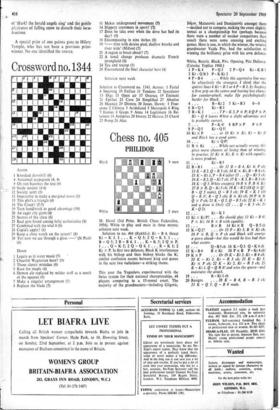Chess no. 405
PHILIDOR
Black White 9 men 5 men M. Havel (3rd Prize, British Chess Federation, 1956). White to play and mate in three moves; solution next week. - Solution to no. 404 (Rukhlis): Kt - B 4, threat
Kt - K 3. 1 . K - Q 5; 2 Q - K 5. 1 . . . B - Q 5; 2 B - B 6. 1 . . . K - K 5; 2 Q X P. 1 . . . Q - K 5; 2 Q - Q 6. 1 . . . R - K I; 2 Kt X P. In first two defences, Black K interferences with his bishop and then bishop blocks the K; similar confusion occurs between king and queen in the next two variations—a striking theme.
This year the Yugoslays experimented with the Swiss system for their national championships, 48 players competing in a 15-round event. The majority of the grandmasters—including Gligoric,
Ivkov, Matanovic and Damjanovic amongst them —decided not to compete, making the event slightly unreal as a championship but (perhaps because there were a number of weaker competitors than usual) there were some amusing and exciting games. Here is one, in which the winner, the veteran grandmaster Vajda Pirc, had the satisfaction of winning the brilliancy prize with his own defence.
White, Baretic. Black, Pirc. Opening, Pirc Defence. (Cateske Toplice 1968.) 1 P-K4 P-Q3 2 P-Q4 Kt-KB3 3 Kt-QB3 P-KKt 3
4 P - B 4 . . . While this aggressive line ma■ be objectively the strongest, 1 think that the quieter lines 4 Kt - B 3 or 4 P - B 3, by keeping a firm grip on the centre and leaving less chance for counter-attack, make life psychologically harder for Black.
B-Kt 2 5 Kt-B3 0-0 6 B-Q3 Kt-B3
7 B-K3.7P-K5,P P;8QP P, Kt - Q 4 leaves White a slight advantage and is probably correct.
. . . P-K4! 8 BP x P P xP
9 P - Q 5 Kt - Q 5!
10 Kt X P . . . or 10 Kt X Kt, Kt - Kt 5!
and Black has a good game.
10 . . . Kt x Q P!
11 B X Kt . . . While not actually wrong, this gives more chances of losing than of winning in practice. 11 Kt X Kt, B x Kt with equality is more prudent.
11 . . . Kt - B5 12 B-B 1 . . . Or 12 B - B 4, Kt X P ch; 13 K-B 2,Q- R 5 ch; 14K x Kt,B-R 6ch; 15 K - Kt 1,P - B 4 (after 15 Q- Kt 5 ch; 16K-B2,Q-K17 ch;17 K-K 3,B-R3 ch; 18 K - Q 3, White escapes); 16 B X P, B X Kt; 17B X R,Q-Kt5ch; 18K-B2(18Q x Q?, B - Q 5 mate), Q - B 5 ch; 19 K - K 1 (19 Q- B 3?, B- Q 5 ch), B X Kt ch; 20 P X B, Q x Pch; 21 K-Q2,Q-B5ch; 22 K-K 1 and a draw is likely (22 . . . Q - K 5 ch; 23 K - Q 2).
12... Kt - K 3
13 Kt x Kt P? . . . He should play 13 Kt - B 6!, P X Kt; 14 B X B with equality.
13 ... B x B 14 Kt x R Q-R 5 ch
15 K - Q 2? .. . Or 15 P - Kt 3, B X Kt ch; 16 P X B, Q X P ch and Black will emerge a pawn ahead—but this would be less bad than what occurs.
15 . . . Q-B5ch 16 K-Q3 Q-K6ch 17 K-B4 B x Kt ISPxB P-Kt4ch!
19 K XP. . . Or 19 K - Kt 3, Kt - B 4 ch;
20 K - Kt 2, Kt - R 5 ch; 21 K - Kt 1,
Kt X P ch; 22 K - Kt 2, Kt - R 5 ch; 23 - Kt 1, Q - Q R 6! and wins the queen—and maintains the attack.
19 . . . R - Kt 1 ch
20 Resigns. . . . 20 K - B 4, B - R 3 ch;
21 K Q 5, Q - B 4 mate.










































 Previous page
Previous page